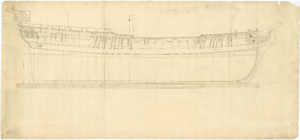HMS Hussar (1763) facts for kids

Hussar
|
|
Quick facts for kids History |
|
|---|---|
| Name | HMS Hussar |
| Ordered | 30 January 1762 |
| Builder | Thomas Inwood, Rotherhithe, England |
| Laid down | 1 April 1762 |
| Launched | 26 August 1763 |
| Completed | 7 November 1763 at Deptford Dockyard |
| Commissioned | August 1763 |
| Fate | Ran aground in New York, 23 November 1780 |
| General characteristics | |
| Class and type | Mermaid-class frigate |
| Tonnage | 627 64⁄94 (bm) |
| Length |
|
| Beam | 33 ft 10+3⁄8 in (10.3 m) |
| Sail plan | Full-rigged ship |
| Complement | 200 |
| Armament | |
HMS Hussar was a British warship from the 1700s. She was a type of ship called a frigate, which was fast and carried 28 cannons. Built in England between 1761 and 1763, Hussar was designed by Sir Thomas Slade. Sadly, she sank near New York in 1780.
Years later, in 2013, a cannon believed to be from Hussar was found in New York's Central Park. Amazingly, it was still loaded with gunpowder and a cannonball!
Life at Sea
Hussar began her service in August 1763 under Captain James Smith. Her first mission was to patrol the waters near Cape Clear Island in Ireland. By 1767, Captain Hyde Parker took command.
The ship then spent several years, from 1768 to 1771, serving off the coast of North America. After this, she was taken out of active service for repairs. From 1774 to 1777, Hussar was refitted at Woolwich.
In July 1777, she returned to duty under Captain Elliott Salter. During the American Revolution, Hussar was an important part of the British fleet in North America. She often carried important messages and orders between different locations.
On November 20, 1779, Hussar successfully captured a Spanish ship called Nuestra Señora del Buen Confeso. This Spanish ship was armed for battle but was being used to carry supplies.
By the middle of 1780, the British forces in New York faced a difficult situation. A French army had joined forces with General George Washington's American troops north of the city.
The Final Voyage
In November 1780, Admiral Sir George Brydges Rodney moved his fleet of twenty warships south. It was decided that the army's money, used to pay the soldiers, should be moved to a safe harbor. This harbor was Gardiners Bay on eastern Long Island.
On November 23, 1780, Hussar's captain, Charles Pole, made a risky decision. He chose to sail from the East River through a very dangerous area called Hell Gate. This narrow waterway is between Randall's Island and Astoria, Queens (on Long Island).
Just before reaching Long Island Sound, Hussar was pushed by the strong currents onto a hidden rock known as Pot Rock. The ship immediately began to sink. Captain Pole could not steer her to shallow water, and she sank in about 16 fathoms (around 96 feet) of water.
The official report from the Royal Navy's investigation into the sinking does not mention any special cargo like payroll money. It suggests that any valuable items on board Hussar had already been removed before the accident.
Searching for the Ship
Even though the British government said there was no gold on the ship, many people believed there were millions of dollars in gold aboard. This belief led to many attempts to find and salvage the Hussar over the next 150 years. Diving in the strong currents of Hell Gate was very difficult.
In 1876, the U.S. Army Corps of Engineers made the passage through the East River much safer. They used 56,000 pounds of dynamite to blast away the most dangerous parts of Hell Gate. Today, it is thought that any remains of Hussar might be buried under landfill in the Bronx.
The Cannon Discovery
On January 11, 2013, something amazing happened in New York's Central Park. Workers from the Central Park Conservancy were cleaning rust from an old cannon. They were shocked to discover that it still contained gunpowder, wadding, and a cannonball!
Police were immediately called to the scene. Bomb disposal experts carefully removed about 1.8 pounds of active black gunpowder from the cannon. They safely disposed of it at a gun range. The New York Police Department made a fun statement, saying, "We silenced British cannon fire in 1776 and we don't want to hear it again in Central Park."

